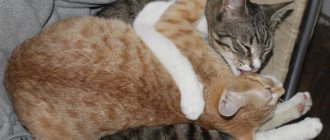14328Administration
1
Many people do not want to have cats because of their tendency to mark all vertical objects in an apartment or house, so the choice often falls on cats. Male felines do this quite regularly, especially after puberty. However, it is difficult to answer unequivocally whether cats mark territory like cats.
In most cases, the owner simply confuses banal urination with a mark. Cats sit down to go to the toilet. When marking objects, they stand with their backs to the surface and raise their tail, releasing a few drops of liquid.
When concerns are confirmed, it is important to know what to do if your cat is marking its territory. The process of castration and sterilization is very stressful for animals and this procedure does not always help.
The main reason for marking is a change of environment, heat, a new family member or animal. The cat reacts to stimuli instinctively, so you should not shout at it. Radical actions generally only make things worse.
What do cat marks look like?
Cats approach any vertical object, straighten their tail and lift it. At this time, a small amount of urine is released. Sometimes cats can change their position, but the main sign of a mark is the release of a very small amount of liquid, no more than 1 ml.
The cat marks the territory
Cats, unlike cats, do not excrete urine to mark their territory, but rather rub their faces against certain objects. Often, owners think that in this way the cat is showing affection or wants to be paid attention to, but here everything is much more complicated. There are special glands near a cat's eyes. They emit a specific smell that humans cannot smell, but other animals immediately begin to understand that the place is occupied.
Among other marks of cats, it is worth noting the sharpening of claws. There are also small glands on the paws of cats, and when they tear objects, they leave a mark wherever they need to. In this case, a person does not feel the smell, but the visible trace is obvious.
Cat mark on the floor
Another way cats mark is by secreting saliva, but this mark does not carry any information.
How can a cat mark territory?
Cats that want to mark things perform the following algorithm of actions:
- fits a vertical surface;
- straightens up and raises its tail, shaking it a little;
- excretes a little urine horizontally.
Sometimes when an animal marks objects, the posture may differ slightly. The main similarity is the extremely small amount of fluid released. Usually it is no more than 1 ml.
To mark territory, cats often rub their faces against certain objects. Many owners think that their pet lacks affection, but in reality everything is much simpler. On the face of cats, near the eyes, there are special glands that produce a strong odor. A person does not feel it, but other animals immediately understand that the place is already occupied.
© shutterstock
You can often notice that cats sniff each other's anus when they meet. The anal glands, which secrete an odorous secretion, are located in this place. Raising its tail, the pet seeks to show its scent. You can notice this if you stroke it along the back. At the same time, the cat will begin to protrude the back of its body.
Cats wash themselves not only to maintain cleanliness, but also to distribute secretions throughout the body.
For example, by licking the genitals, they spread the smell from the anal glands along the back of the body. The secret will be more clearly visible to other animals.
Representatives of the cat family have very small glands on their paws. When cats sharpen their nails, they mark objects. This leaves visual marks and a corresponding smell.
Cats can mark not only with the help of fluid secreted by the glands, but also with saliva . However, it does not carry any information about the animal’s sexual behavior, for example, about the onset of estrus.
Duration and frequency of sexual heat
Characteristic behavior lasts from 3 to 10 days. The period when a cat is in sexual heat and allows a cat to approach her is called estrus. At this time, the ovarian follicles produce the maximum amount of estrogens and sex hormones.
In the very first days of estrus (1-4 days), the cat demonstrates sexual arousal, but does not allow mating. This time is called proestrus, “forerunner”. Unlike dogs, cats do not have a clear boundary between estrus and proestrus, and it is difficult to determine these periods.
If sexual intercourse does not occur during estrus, then ovulation does not occur. In this case, sexual heat returns every 10-14 days. The period between estrus is called interestrus, this is a time of rest for the uterus and ovaries. In some cats, the concentration of estrogen in the blood does not decrease, and the animal walks constantly.
Prolonged heat is a sign of follicular ovarian cysts, which must be removed surgically.
Complete rest of the ovaries, which means the absence of the reproductive instinct, is called anestrus, the absence of estrus. In stray cats, this period occurs in late autumn or winter, due to short daylight hours and the action of the hormone melatonin. Anestrus does not occur in domestic cats due to constant light and nutritious food.
A distinctive feature of the breeding system in cats is induced ovulation. Simply put, an egg is released from the ovary only in response to vaginal stimulation. Natural ovulation occurs due to mating, but artificial ovulation is also possible - as a result of manipulations in the vagina.
Ovulation occurs 1-2 days after intercourse, and after another 1-2 days the estrus stops. The ovary forms the corpus luteum, which produces the hormone progesterone to maintain pregnancy.
If the egg is released and fertilization does not occur, progesterone will be produced “by inertia” for 1-1.5 months (less than a true pregnancy). Progesterone prevents the resumption of estrus.
We suggest you read: Large breeds of pigs - choice for breeding
In cats, sexual function does not decline until death; even at 16-19 years of age, estrus is observed from time to time in non-sterilized animals.
I'm 14 years old, motherfucker, how old can you be?
How is marking different from urination?
When cats begin to mark, they leave the smell of urine in the room or rub their faces against the furniture, leaving behind an odorous trail from special glands located near the eyes and on the paws.
How to stop a cat from marking territory in an apartment
If a cat rubs against furniture, then in this way she makes it clear that she is calm in this house and she feels protected. Marks left by urine are a kind of manifestation of aggression and thus, a cat shows its rights to own a particular territory.
Important! Basically, this reaction occurs in connection with the appearance of another animal in the house or as a result of a change in the usual environment.
Most owners are concerned with the question of how to distinguish a territory mark from arbitrary urination past the tray. If the cat just wants to go to the toilet, then she does it while sitting. If it leaves a mark, it does so while standing on all fours, lifting its tail up and leaving a small amount of liquid. This behavior is typical not only of cats, but also of males, especially during sexual desire.
Content
1. Why does the cat mark in the house 2. Why does this happen in the apartment 3. The cat marks - will castration help? 4. How to stop a cat from marking
The cat family is a unique representative of the animal world. The owner of an ordinary domestic cat requires a certain diligence and understanding of the pet's problems, its basic instincts and rules. Only mutual correction and the right actions will achieve results. One of the main problems with their maintenance is the situation when the cat marks the territory. In the wild this is a natural process, but the owner's apartment is not a meadow or a park. In a confined space, an unpleasant odor is constantly felt, and with intensive irrigation of surfaces, even a change in color is possible. In 99% of cases this is done by males, for which they have certain natural reasons.
What time do cats start marking their territory?
Cats fight: the main reasons for the behavior and what can be done to wean them off
This criterion is conditional, and marks left by cats can become noticeable in different ways. It all depends on the age of the animal, its character, nutrition and living conditions. According to veterinarians, on average, cats begin to leave marks from the age of eight months, because it is during this period that hormone levels rise, and the cat is looking for a way to attract a sexual partner.
For your information! The marks are accompanied not only by marks on furniture and curtains, but also by calling cries.
Also, the period when territory marking begins can be tracked by the behavior of the animal; you can observe it quite carefully. When puberty occurs, character and behavior changes, the body acquires clear outlines and becomes muscular.
During this same period, aggressive behavior towards other animals occurs. Pets often begin to mark their territory as a defense.
Why does a pet mark?
The reasons why a pet may suddenly begin to mark various surfaces in a house or apartment are varied. Let's look at the three most common ones.
Instinct
A domestic cat may begin to mark its territory for natural reasons. Being a territorial predator, these furry animals have an instinct that pushes them to damage things and furniture. Thus, the animal protects its territory from the encroachments of its relatives.
This problem also arises when the animal enters puberty. Therefore, it is important to know at what age cats begin to mark. This usually happens when pets reach 7–8 months. When a cat is in heat, she may also leave marks on furniture and carpets.
You need to understand that instinct is very difficult to fight. But you can still change your pet’s behavior for the better. What needs to be done for this will be described below.
When other animals or strangers appear in the house, the cat may begin to place its marks in the corner of the room. Moreover, a neutered pet can also exhibit this behavior.
Not only a cat, but also a cat can leave these specific marks. Females, albeit very rarely, can also mark territory under the influence of instinct. This usually happens when another pet appears in the house. This way the cat shows who is boss in the apartment.
This behavior may go away on its own when the animal gets used to the stranger. Give your pet time, and he will calm down on his own and get used to the new environment.
We suggest you read: Cats mark everything in the house: tips on what to do, how to wean and remove the smell
Not all cats begin to mark surfaces when strangers appear in the house. This is usually done by restless animals that react strongly to external factors.
Illness and stress
Specific markings may appear anywhere in the house if the pet is sick or under extreme stress. Moreover, this phenomenon does not depend on age, gender and breed.
These animals experience stress when moving, long journeys, protracted illness, frequent and prolonged absence of the owner, etc. Therefore, you should always pay enough attention to your four-legged friend, since it is very difficult to wean him from a bad habit.
If the cause lies in illness, the animal must be cured. In this case, you don’t even have to dare your pet. He may well quit marking his territory after his recovery. As he gets better, the desire to leave marks will decrease. Although after treatment the animal can continue to cause harm.
If a young animal lives in the house, it will be useful for the owner to know in advance what to do to prevent the cat from marking the territory. First of all, the animal begins to perform such actions that irritate household members at the age of 6 - 10 months. Small kittens do not mark their territory until puberty. Therefore, the owner should carefully monitor the appearance of signs of puberty in a young male.
It is almost impossible to prevent the manifestation of natural instincts, but proper training of a pet from the first days of its stay in the house will help to avoid negative behavior in the future.
First of all, the little kitten needs to make it clear who is in charge in the house. An animal should not be raised in permissiveness; this will confirm the young male that he is the leader.
Having discovered that a cat is marking its territory, every owner is concerned about how to deal with it. If the animal is young, it is often prompted to leave marks by lack of attention from members of the household. Being constantly alone, a pet can attract attention to itself using a natural mechanism known to it - putting marks on furniture, household items, and the owner’s belongings. This is how the animal tries to attract attention to itself using the means available to it.
If the cause of cat marks is boredom and loneliness, the owner should make an effort and pay enough attention. In the absence of the owner of the house, it is advisable to purchase a gaming complex and leave toys for the cat.
The owner should understand that neither shouting, nor assault, nor throwing slippers and other objects at the cat will have any positive effect. On the contrary, the animal will become convinced that its self-preservation is threatened, and the actions of leaving marks will become more active. Therefore, in the matter of weaning a male from behavior that is unseemly from the point of view of household members, there should be no forceful influence.
Hormones
In an animal’s body, hormones can be produced not only in the ovaries: sometimes the cause of estrus is hormones produced by the adrenal glands, sometimes by the pituitary gland.
In rare cases, production may occur in a hormone-producing tumor.
The manifestation of such developments in a cat depends on its age at the time of spay removal. In young cats, the production of hormones by other organs occurs several times less frequently than in older females.
To make sure that the cause of estrus is not a tumor, it is better to take the cat to the clinic for an examination and undergo all hormone tests.
The cat marks the territory: the main reasons for unwanted behavior
How to stop a dog from marking in the apartment: what to do
The smell left by a cat is a unique way of communication between animals. By leaving marks around the house or yard, they seem to show strangers that this territory has an owner and it is better not to set foot here. With the help of such marks, living in the wild, the animal provides itself with protection and the opportunity to get some food.
As for domestic animals, they also leave marks, but this already happens at the level of instinct. There are several main reasons for leaving such traces:
- puberty;
- the appearance of a new pet in the house or a change of environment;
- there is not one cat living in the house, but several;
- the owner smells of another cat;
- stressful situations, such as renovations or moving.
Why does a cat mark in the house?
All cats, from tigers and lions to domestic pets, have an extremely acute sense of smell. They navigate the world of smells, reading the environment from the subtlest notes left by other animals of their own or another species. Having a territorial attachment, they try to mark their own possessions with a mixture of urine, hormones and special secretions produced by the gonads. On the street this phenomenon happens unnoticed, no one pays attention to the marks, but in an apartment or house it turns into a big inconvenience. Guests will immediately ask if there is a cat in the home.
The animal simply marks its property. If in dogs the mark says something like “I was here,” then in cats it means “this is mine, get out of here.” Aliens who invade the property will definitely get a fight, which most often happens in the spring. The area covered means the claim to dominance, females and food available in the area.
False pregnancy
After sterilization, a cat can be deceived by its own hormones. False pregnancy is a common occurrence in cats, and hormonal imbalances can trigger it. In addition, if mating has been made with a male, the female may also subsequently decide that she is pregnant.
A cat owner can identify the problem by a number of characteristic signs:
- the pet begins to look for a “nest” for itself: rummaging in closets and other secluded corners;
- change in behavior: females often become overly affectionate, or, conversely, do not want to make contact with people;
- the cat begins to carry various small objects (“kittens”) in its teeth.
You may also notice increased discharge from the vulva, enlargement of the abdomen and nipples, milk production, changes in appetite and other symptoms.
The manifestation of a false pregnancy after sterilization should be discussed with a veterinarian. This is very important, because sometimes such a failure can lead to the development of such unpleasant diseases as mastitis, pyometra, and in rare cases, tumors and endometritis.
Why does a cat mark its owner?
It is surprising not only how cats mark territory, but also why they mark their owner, who feeds them, shows care and looks after them?
There may be two options here:
- The pet is trying to challenge the rights of the owner and force him to act according to his own rules. This behavior is typical of cats or cats that came into the house as adults from the street and are accustomed to defending their place in the sun.
- In the second case, by leaving marks on the owner, the animal thus marks that it is his and no one else’s. And this is so, because someone else’s cat will never approach a “marked” person.
What to do if your cat is marking his territory
Any domestic cat or male cat is not so far removed from its wild relatives. Nocturnal lifestyle, hunting habits and, of course, territory marking. And while in some cases it’s just harmless rubbing or a slight scratch, urine marks cause a lot of trouble. If a cat marks the territory of the house, you have a chance to wean him from doing this.
Why does a cat mark territory?
Smell is the primary way cats communicate. For example, when one cat comes home from the vet, the other cats in the family may initially treat it as a stranger. This is due to someone else's unfamiliar smell. But since the animal cannot be in several places at the same time to observe its territory, it can leave its scent as a kind of calling card.
Friction tagging
Both females and males can mark territory by friction. Special glands located on the animal’s cheeks, sides and paws allow it to leave its scent on any object: a door, a chair leg, a corner of a wall or sofa, etc. If a cat rubs against you, it marks you as its property.
If there is more than one animal in the house, then the marks may overlap. This is why cats sometimes wash each other or rub their sides together - to relieve tension and disputes over territory.
Scratch marking
Scratches on furniture and walls, torn sofas and wallpaper are more than just a claw point. In this way, cats also leave their scent on surrounding objects. Special glands located on the paw pads secrete a substance that acts as a personal marking for the animal. Therefore, instead of punishing a damaged item, install a scratching post at home and teach your cat to use it.
Urine marking
Urine marks are the worst. They have an unpleasant specific odor with great stability. And if an animal marks upholstered furniture or a carpet, then most likely it will have to be thrown away. Urine marking takes two forms:
- leaving marks on vertical surfaces;
- leaving marks on horizontal surfaces.
In the first case, the cat marks a vertical surface, while its tail trembles slightly. In the second case, this is banal urination on the floor, on the carpet or any other horizontal surface.
A cat or cat marks the territory of the house: the main reasons
There are several possible reasons why an animal marks its surroundings with urine.
1. Medical problems. Health problems can be one of the main reasons, especially in cats. So, for example, a urinary tract infection—or worse, a blockage—could be to blame if the pet suddenly stops using the litter box. Some cats will even urinate and cry loudly or get confused to do so right in front of you to let you know that something is wrong.
2. Mating behavior. In intact (uncastrated or unsterilized) animals, the instinct to mark territory is very strong. In fact, it cannot be removed. Therefore, one of the methods is sterilization or castration upon reaching 5 months of age.
3. Stress. Cats are creatures of habit, and many react poorly to even the slightest changes in their environment. This can include everything from a new pet or child in the house, to an owner being away for a long time, a stray cat in the backyard, and other environmental factors that we don't even notice. Marking your territory with urine is a way to cope with stress. And to get rid of it, they strengthen their boundaries with these marks.
How to solve the problem of urine marking
First things first, let your cat know that this behavior is inappropriate. To do this, isolate her or punish her in some other way. But don't overdo it: punishment can cause stress, and stress can cause new marks.
Second, clean the contaminated areas. Avoid using strong-smelling cleaning products because they may cause your pet to pick up the stain. Then make the area inaccessible or unattractive. For example, fence it off.
Put all things with new smells in the closet. A new rug, shoes, guests' belongings and shoes can all look like very attractive places to tag.
If health problems are ruled out and the marks are the result of stress, then a short course of anti-anxiety medications may help the animal. Talk to your veterinarian about this.
tell friends
Vkontakte Facebook
How long do cats mark after castration?
If a pet lives in an apartment and the owner wants it to stop marking its territory, then the only solution in this case will be castration or sterilization. This operation is performed during puberty.
After surgery, the animal may leave marks for some time. This is because the hormonal background of an animal cannot change in one day, but this will take about 2 months, or maybe more.
Worth knowing! If castration was carried out several years after the onset of puberty, then the desired effect may not be achieved.
How to stop an adult cat from marking territory in an apartment
The most popular question is what to do if a cat marks in the apartment and it is not a young pet. An adult animal is not so easy to train and can leave marks to spite its owner. To stop this behavior of an adult cat, you can go in two ways:
- Use of substances with a strong odor. You can buy a chemical at a pet store or use vinegar, potassium permanganate, ammonia, or lemon juice. Do not treat corners with a bleach-based solution.
- Castration will help. However, after cutting the cords connecting the testes, the pet can continue to mark its possessions.
Advice! As a last resort, you can use women's or men's perfume with a persistent odor.
Why doesn't castration or sterilization always solve the problem?
Sometimes a neutered cat marks its territory even after a long time after surgery. It continues to do this if:
- was castrated in old age and leaving marks became his habit;
- has such a feature as cryptorchidism, when one or both testicles are located not in the scrotum, as it should be normally, but in the groin area or abdominal cavity, and during the operation an inexperienced surgeon did not take this point into account;
- there are other relatives in the home - a castrated animal still has to protect its personal boundaries.
Repelling with foil, sprays and other methods
If a cat is marking its territory, what to do is a question that cannot be answered definitively. There are several methods.
You can scare away your pet by using regular foil. Basically, the animal chooses one or several places for its tracks. Having found them, you need to lay foil there. Cats do not like to touch this material because the rustling sound irritates them.
You can stop your cat from marking his territory using foil.
If you don’t have time for experiments, then you can purchase a proven product in the form of a spray, which contains cat pheromones that help improve the psychological state of the animal. You can purchase this product at a pet store.
Advice! When you have absolutely nothing at hand, you can use folk remedies, for example, lemon juice or citrus-scented essential oils. Their smell has a deterrent effect on cats.
Why cats mark and what to do about it
Contents hide
We know: with our publication we are stepping on a sore spot of cat lovers. But there is no way to ignore the topic or pass it by in silence. The persistent smell of urine is a characteristic companion of many domestic purrs, the other side of the coin in their maintenance. You won’t be able to completely avoid the problem; you can only weaken it with your skillful and competent actions. Let's figure out why cats mark and why there is an unpleasant smell in your house.
Instinct of procreation. Even people far from the world of cats know how wonderful the month of March is for mustachioed tabbies. Cats actively mark their territory: firstly, they attract beautiful ladies, and secondly, they scare away potential competitors. Adult cats also mark during an interesting period: they make themselves known to the seals. Cat urine contains unique pheromones that drive cats crazy. There is only one way out, and, alas, it is radical: you need to castrate (sterilize) your pets. It is better to perform the operation while still a young kitten.
Territorial instinct. Observe the behavior patterns of adult cats - how, while “patrolling” their territory, from time to time they attach themselves to some object and apply a mark and spray urine. This also applies to domestic cats - it’s not for nothing that there is a common expression “the apartment smells of cats.” The tags are read by other “competitor” cats. Violent fights like “who’s boss in the area” often break out. Territorial marks are left by both uncastrated cats (most often) and castrated cats (much less often). Please note: as a rule, apartments that contain many cats - not two or even three - acquire a characteristic smell. Animals compete with each other and cannot divide the living space. Try calming synthetic pheromones. In some cases, pets will have to be separated. No matter how cruel it may sound, some of the mustaches should have been transferred to a shelter - especially when the matter took a serious turn, problems arose with neighbors and even with the police.
Urinary tract diseases and other problems. Now we are mainly talking about “indoor” cats that started urinating anywhere. If the problem arose in the midst of everyone’s well-being, moreover, it is not one-time in nature, but is only getting worse - take the animal to the veterinarian. There can be many reasons: diabetes, kidney disease, bladder infections, and much more.
The reason may also be of a non-trivial nature. For example, an ingrown claw has formed an open wound. The cat enters the tray, the filler (wood dust) digs into the wound and causes pain. Purr begins to associate pain with being in the litter box and refuses to go there. It should be emphasized that cats suffering from arthritis experience pain while visiting the litter box, because every movement causes pain. Try to buy a tray with low sides: it is much more convenient for elderly and sick animals to use.
Maintain cleanliness and hygiene. Don’t be lazy about cleaning the litter box – this is a truism. Clean every day. Change the filler more often. The characteristic aroma from the litter box is unpleasant for both people and their pets. Often cats refuse to use the litter box for the only reason: the owners clean it up from time to time. The purrs tolerate it for some time, then the problem grows like a snowball. Don't forget: each of your cats (if there are several of them in the house) should have its own litter box.
The most important detail: get rid of “foreign” urine odors immediately. These smells attract cats, encouraging them to do their business in this place again. For example, your pet for some reason urinated on the carpet in the living room. Thorough cleaning should be done immediately; otherwise, your carpet will continue to be perceived as a comfortable toilet.
How to distinguish a “problem” from a “non-problem”? Let's use different terms. An adult healthy cat “marks” - that is, sprays urine onto any vertical surface (wall, door, etc.). Thus, he leaves notes for his relatives. This is a natural and completely normal behavior pattern. A “problem” can be called urination on a horizontal surface outside the tray. Such an animal must be checked for diseases. Plus an indispensable condition: the more cats there are in the house, the more critical the situation becomes.
How to deal with urine stains and get rid of unpleasant odors is described in one of our recent publications - just follow the link. Visit our website ilike.pet - there is a lot of other interesting information on this burning topic.
Original text. Material used: Why Do Cats Spray Urine? Author: Susan Logan McCracken. Source: catster . com . Photo: 1 zoom . me (from open sources).
What to do when a cat marks in the house and how to stop it
If a cat marks objects in the house, then the surest way to stop him from doing this is castration. But changes in the animal’s hormonal background will continue to occur for quite a long time. In this case, there are several effective ways, not so drastic:
- Place peels of citrus fruits, the aroma of which animals cannot tolerate, in places where there are regular marks.
- Buy a special repellent spray.
- If the appearance of marks is associated with stressful situations, you must try to eliminate them by paying more attention to the animal.
- If the cat was caught in the act of a crime, then you need to lift it by the scruff of the neck and hiss, looking into the eyes. Hold the animal until it starts meowing and averting its eyes.
Worth knowing! There is no one 100% effective way to stop marking territory, because it is a natural instinct against which animals are powerless. But the above methods will help you get rid of leaving marks at least for a while.
The cat marks in the house
Video “How to wean a cat from taking revenge and shitting”
The following methods will help stop cats from marking entrance doors:
- The door must be thoroughly washed.
- Apply a strong-smelling substance to its surface - ammonia, a solution of bleach. You can wipe the surface with a lemon cut in half.
- Scatter spices, such as red pepper, mustard, near the door mat.
If other people's cats are marking their territory, then you can fight this phenomenon with the help of an ultrasonic repeller. The device emits waves of a certain frequency into the environment, which are perceived negatively by cats, and they avoid the area.
You can wean a cat from marking territory on the street in a private house in two ways - by distraction and scaring away. You can distract from an unwanted habit by setting up a special corner for your naughty pet. For this purpose, you need to choose a suitable place in your garden and cover it with sand, in which cats love to dig. To make the corner attractive to the animal, you can plant catnip around its perimeter.
You can stop your cat from marking his territory by using repellents. You can purchase special liquidators and tag destroyers at the pet store. The products have a repellent effect and can be used to treat different surfaces.
We suggest you read: Which spider is the fastest in the world?
There are different ways to stop a cat from marking at the entrance:
- Neuter all animals living in the area. This, of course, is a difficult but radical measure to combat cat marks.
- Place a door in the entrance, thereby preventing access of unauthorized animals to the premises.
- Regularly treat surfaces (walls, floors, handrails, etc.) with products with a repellent effect.
However, when getting a cat, you need to take into account that he will soon begin to mark his territory, and this is a real problem if the animal lives in a city apartment. More precisely, mature cats lift their tail and twitch it a little, releasing small portions of urine. Thus, animals leave odorous marks, which are a message for their relatives.
This message provides information about the cat's age and readiness to mate, so it is not just a habit, but an instinct. Of course, the smell of cat marks is not audible to a person on the street, but in an apartment it is clearly visible. It is very difficult to wean a cat from this activity.
1. castrate the cat;
2. take the place of the dominant male himself.
Castration of a cat at the age of 7-8 months in most cases avoids problems with marks. However, a small part of cats, even after castration, continue to leave marks, but the smell of urine will no longer be as strong and long-lasting. Therefore, if you are not going to breed kittens, simply castrate your pet. By the way, those cats that have the opportunity to regularly mate with female cats practically do not mark their territory.
The second method implies that you will have to try on the role of a dominant animal and behave according to your new position. For example, if your pet is going to refresh its marks once again, you should lift the cat by the withers and, looking him straight in the eyes, hiss intimidatingly.
Of course, the cat may rebel and challenge your authority, but a couple of such educational procedures, and your cat will only obsequiously tuck its tail and ears in your presence.
Marks are, although unpleasant, but by no means fatal, a circumstance of your life together with a cat. The cat, just like the owner, has the right to living square meters and a separate bedroom. Another thing is that when bringing an animal into the house, you need to be prepared for such surprises and think through a plan of action in advance.
In this video, a specialist will tell you how to stop a cat from taking revenge and shitting.
Poor operation
A careless choice of the clinic and the doctor who performed the sterilization could lead to the fact that an inexperienced veterinarian did not remove all the ovaries. Even if part of the organ remains not removed, the production of hormones continues, and the cat may begin to ask for a cat.
To save the cat from the consequences of poor-quality sterilization, another operation will be required. This time you need to take your choice of doctor seriously.
We suggest you read: Why does a cat have an enlarged liver? A cat has an enlarged liver is the cause of the disease
Is it possible to wean a neutered cat from the habit of marking premises?
If the cat is neutered and still continues to mark the territory, this can be facilitated either by stress, for example, due to a change in environment, or by a complete lack of attention from the owners.
You should definitely remove traces of cat marks by wiping the area with vinegar or spraying special deodorizing agents that are sold in veterinary pharmacies. Special cat pheromones, which are currently on sale, will also help to wean the animal from marking. But before using them, you should consult a veterinarian.
How to stop marking
If eliminating the causes of bad behavior does not help, then you need to move on to more decisive action. What to do when a cat marks - firstly, you need to catch it “in the act” and punish it immediately. Over time, the animal will associate the punishment not with its action, but simply with you, and then you will get the completely opposite effect. If your cat marks corners, you can also try to make her favorite places as unattractive as possible - rinse thoroughly (but do not use products containing ammonia, as its smell is similar to urine). You can also spray the corners with your perfume, leaving your own mark, so to speak, or use other strong-smelling substances - a lemon drop, for example.
If your pet leaves marks only during the period of heat - the cat asks the cat and marks, then medications can help, but before using them you should definitely consult a veterinarian, since the effect is quite strong, and side effects often occur. In addition, after stopping the use of the medicine, the cat’s bad habit begins to appear again.
What to do if your cat is marking her territory during heat
A very difficult period for the owner is the moment when a cat begins to mark its territory during estrus. In this situation, you should not shout or intimidate, because such methods will not help.
It's worth using a few tips:
- Talk to the animal in a quiet and calm voice, without showing aggression.
- Pet him on the head or tummy, but under no circumstances should you touch the tail.
- To drive excess energy out of your pet, you should periodically give him different tasks, for example, catch a mouse and bring a toy.
- Give food in very small portions, but access to water should be constant.
- You can bathe your cat in warm water, but make sure that there are no drafts in the room.
All these methods calm the animal and relieve stress, as a result of which there is every chance that it will stop crap in the room.
At what age do cats start leaving marks, and for what reason?
What time do cats start marking? Animals leave their first marks as soon as they reach sexual maturity. Typically, cats begin to mark their territory at the age of 6-9 months, depending on the breed. For example, among representatives of the eastern group (Siamese, Thai), puberty begins earlier. For large pets (Maine Coons, Siberians), a little later. For example, a British cat begins to mark at about 7 months .
If an animal begins to leave marks in the apartment, although this has not been observed before, the reasons may be different. Including:
- Reaching puberty . In this case, the pet will ask for the cat, while leaving marks and showing itself as an “alpha male”. To prevent the animal from wanting to update its tags, you need to try to fix the problem. To do this, you need to use substances with a pungent odor, then wipe or soak the already marked areas with cotton swabs. For example: vinegar, ammonia, potassium permanganate. The disadvantage of this method is that the smell will fade away over time, and you will have to repeat everything again, since it is quite difficult to wean the cat the first time.
- Stress or pain . For example, this could be moving to a new apartment, or even just changing furniture. Marks with their own characteristic odor allow the animal to calm down and feel safe. In this situation, it is best to try to calm the cat down and distract him with games. Often, odorous marks also serve as a signal of the onset or exacerbation of the disease. Here you will need to talk with a specialist.
- Feeling of jealousy . When there are other animals, small children in the house, or guests sometimes drop by, it is important not to forget about your pet. Cats begin to mark their territory out of serious jealousy, leaving marks with even greater zeal and reminding them of themselves. You can also try to make amends by treating him to something tasty. But it is better to avoid such situations.
- Lack of attention . When you devote little time to the animal, for example: you don’t pick it up, don’t play, the cat begins to settle personal scores. It is not surprising that it is the owner’s personal belongings that suffer: a sweater, boots, or even a pillowcase. It is necessary on your part to show prudence and make reconciliation: resume your previous games, show that you still respect and appreciate your pet. The animal will reciprocate your feelings.
- Dirty tray . Remember to thoroughly clean your cat's litter box. Cats are usually very clean.
How to find cat marks
To find a cat's mark, you can use an ultraviolet flashlight. If you turn off the lights in the apartment and turn on the flashlight, the marks left by the cat will be illuminated with green light. Thus, you won’t have to wash half the apartment, but it will be enough to eliminate only the trace left behind, which emits a cutting, foul odor.
Traces of cat marks under ultraviolet light
Tag prevention
To prevent the appearance of marks in the house, experienced breeders and veterinarians recommend using the following measures:
- Emasculation. An effective method of preventing the appearance of marks, only if the operation is performed before the onset of puberty.
- Proper education. This is not the most effective method, because if leadership qualities are inherent in a cat’s nature, then it will be quite difficult to fight them. If the cat is obedient and flexible, then with proper upbringing everything can work out.
- Accommodation in an apartment for a female and a male. This method does not fully guarantee that the cat will stop marking its territory. In addition, there will be another problem associated with permanent offspring.
Thus, there is no 100% effective way to prevent marks in a Scotsman, Briton or other breed, but you can fight marks with the help of educational and hygienic measures.
Why do cats leave marks?
An animal that has reached sexual maturity is obliged to periodically inform other females and males about its existence.
Main reasons:
- The cat marks its territory and makes it clear that it will not tolerate intrusion into it. For the same purpose, he marks the front door, as he senses other males who are outside.
- Attracts the attention of females when they are in heat and shows their readiness to mate.
- Another pet appears in the house, which is perceived as a rival.
- The cat has health problems.
- Boredom. Household members do not engage with the animal enough, and he tries to attract attention. A characteristic feature is that it marks the owners’ things.
- Stress or fear. The reason may be moving to a new place, rearranging furniture, etc.
Disease
The cat marks as if to spite its owner. They did everything to her: they scolded her, spanked her, and poked her nose. No, he doesn't understand. Runs away from the crime scene on half-bent legs, with blocked ears. But he continues to do his job.
Do not rush to scold your favorite. Perhaps the whole point is that the animal simply does not always have time to reach the tray. If a cat has cystitis or urolithiasis, punishment will not help. The animal must be treated; this is impossible to do at home. Therefore, you will have to take your pet, put it in a carrier and rush to the veterinarian. The faster, the better for everyone. Because only a specialist can determine the presence of diseases associated with the bladder.











